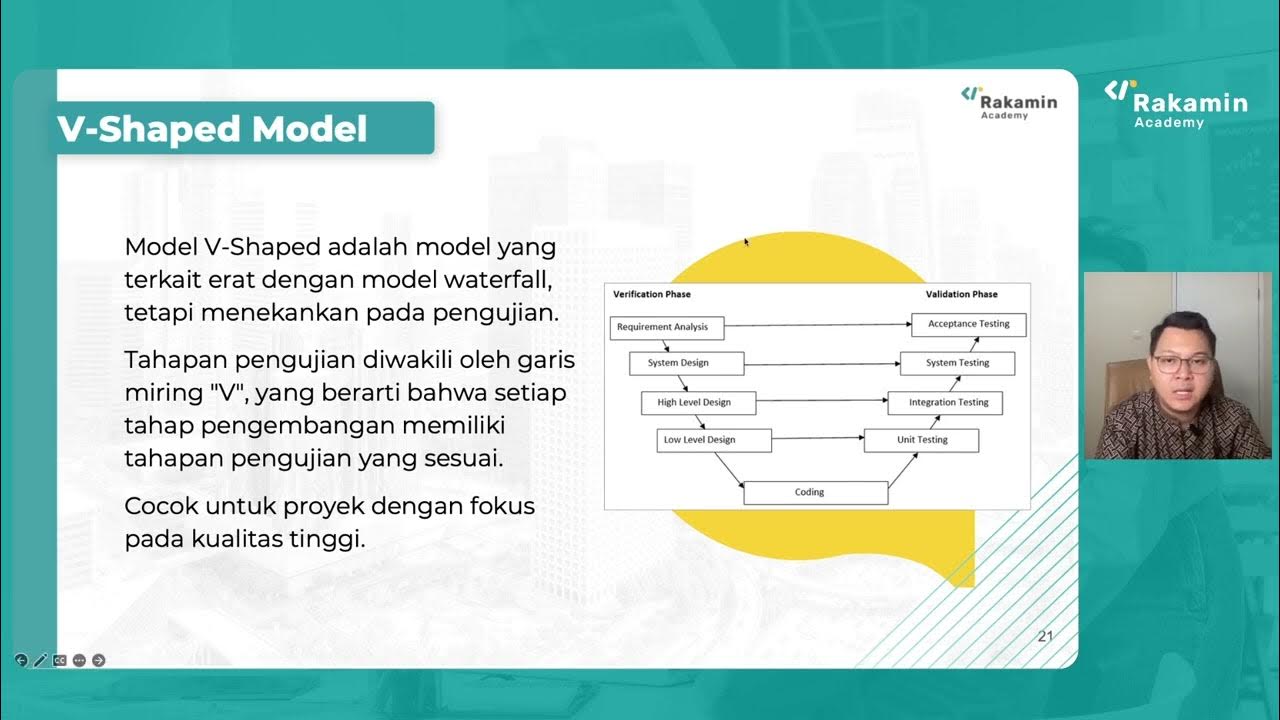Lecture 07: Life Cycle Model (Contd.)
Summary
TLDRThe video script delves into the Life Cycle Model, exploring various software development methodologies such as Waterfall, V Model, Evolutionary Model, Prototyping, and Spiral Model. It contrasts Classical Models with Agile Models, highlighting their differences and emergence in modern projects. The script emphasizes the importance of the traditional Waterfall Model in systematic software development, detailing its stages from feasibility study to maintenance, and its adaptability to evolving software needs. The discussion also touches on the necessity for careful project management, considering financial and technical feasibility, customer requirements, and the ultimate goal of efficient software development.
Takeaways
- 📈 The lecture discusses various fundamental concepts related to the Life Cycle Model in software development.
- 🌊 It introduces several popular Life Cycle Models such as Waterfall, V Model, Evolutionary Model, Prototyping Model, and Spiral Model, collectively referred to as Classical Models.
- 🔄 The script contrasts Classical Models with Agile Models, which have emerged more recently and are preferred for modern projects due to their adaptability.
- 🔧 The software life cycle is described as a sequence of phases including Feasibility Study, Requirement Analysis, Design, Specification, Coding, Testing, and Maintenance.
- 💡 The Traditional Waterfall Model is highlighted as a very structured approach where each phase is completed before moving to the next, resembling a cascading waterfall.
- 🛠️ The importance of conducting a Feasibility Study is emphasized to determine the project's viability from technical, economic, and operational perspectives.
- 🔍 The script explains the necessity of Requirement Analysis and Specification to understand the software's needs and functionalities before development begins.
- 🔄 The iterative nature of Agile Models is mentioned, allowing for continuous improvement and adaptation to changes, unlike the more rigid Waterfall Model.
- 👷♂️ The role of a Project Manager in overseeing the project's phases, making decisions, and ensuring the project meets its objectives is outlined.
- 💻 The script touches on the technical aspects that need to be considered, such as data handling, system interactions, and the expected outcomes of the software development process.
- 📉 The potential downsides of the Waterfall Model, such as the difficulty in making changes once a phase is completed, are discussed, highlighting the need for more flexible models like Agile.
Q & A
What is the main topic discussed in the provided script?
-The main topic discussed in the script is the various life cycle models in software development, including Classical and Agile Models, and their differences.
What are the key phases of the traditional Waterfall Model mentioned in the script?
-The key phases of the traditional Waterfall Model mentioned are Feasibility Study, Requirement Analysis, Design, Specification, Coding, Testing, and Maintenance.
What does the script suggest about the relevance of the Waterfall Model in modern software development?
-The script suggests that while the Waterfall Model is straightforward and clear, it is less adaptable to the rapidly evolving needs of modern software development, which is why Agile Models have become more popular.
What is the significance of the Feasibility Study in the context of the script?
-The Feasibility Study is significant as it is the first phase in the traditional Waterfall Model, where the project's viability, including technical, economic, and operational aspects, is assessed.
How does the script describe the process of requirement analysis in software development?
-The script describes the process of requirement analysis as a critical phase where the software's necessary functionalities are identified and documented in detail for further development.
What is the role of the Design phase in the traditional Waterfall Model as per the script?
-In the traditional Waterfall Model, the Design phase follows the requirement analysis and involves creating a detailed blueprint of the software architecture, user interfaces, and system components.
What is the importance of the Coding phase in the script's discussion of software development?
-The Coding phase is important as it is where the actual software development takes place based on the design specifications, translating the design into a functional software product.
How does the script address the importance of Testing in the software development life cycle?
-The script addresses the importance of Testing as a phase where the developed software is rigorously checked for defects, ensuring it meets the specified requirements and is ready for deployment.
What is the Maintenance phase as described in the script, and why is it crucial?
-The Maintenance phase, as described in the script, is the ongoing process of improving and updating the software after its release to fix bugs, improve performance, and add new features, ensuring its continued relevance and functionality.
How does the script differentiate between Classical and Agile Models in software development?
-The script differentiates Classical and Agile Models by highlighting that Classical Models, like the Waterfall Model, are more linear and sequential, while Agile Models are more flexible, iterative, and adaptive to changes.
What is the script's perspective on the evolution of software development models over the years?
-The script's perspective is that software development models have evolved from Classical Models to Agile Models to better accommodate the fast-paced and dynamic nature of software development, with Agile Models gaining prominence in recent years.
Outlines

Cette section est réservée aux utilisateurs payants. Améliorez votre compte pour accéder à cette section.
Améliorer maintenantMindmap

Cette section est réservée aux utilisateurs payants. Améliorez votre compte pour accéder à cette section.
Améliorer maintenantKeywords

Cette section est réservée aux utilisateurs payants. Améliorez votre compte pour accéder à cette section.
Améliorer maintenantHighlights

Cette section est réservée aux utilisateurs payants. Améliorez votre compte pour accéder à cette section.
Améliorer maintenantTranscripts

Cette section est réservée aux utilisateurs payants. Améliorez votre compte pour accéder à cette section.
Améliorer maintenant5.0 / 5 (0 votes)






